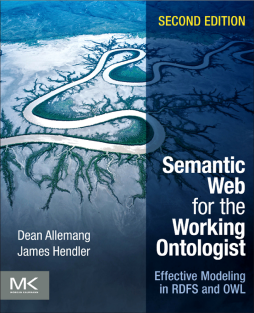
Additional Information
Book Details
Abstract
Semantic Web for the Working Ontologist: Effective Modeling in RDFS and OWL, Second Edition, discusses the capabilities of Semantic Web modeling languages, such as RDFS (Resource Description Framework Schema) and OWL (Web Ontology Language). Organized into 16 chapters, the book provides examples to illustrate the use of Semantic Web technologies in solving common modeling problems. It uses the life and works of William Shakespeare to demonstrate some of the most basic capabilities of the Semantic Web. The book first provides an overview of the Semantic Web and aspects of the Web. It then discusses semantic modeling and how it can support the development from chaotic information gathering to one characterized by information sharing, cooperation, and collaboration. It also explains the use of RDF to implement the Semantic Web by allowing information to be distributed over the Web, along with the use of SPARQL to access RDF data. Moreover, the reader is introduced to components that make up a Semantic Web deployment and how they fit together, the concept of inferencing in the Semantic Web, and how RDFS differs from other schema languages. Finally, the book considers the use of SKOS (Simple Knowledge Organization System) to manage vocabularies by taking advantage of the inferencing structure of RDFS-Plus. This book is intended for the working ontologist who is trying to create a domain model on the Semantic Web.
- Updated with the latest developments and advances in Semantic Web technologies for organizing, querying, and processing information, including SPARQL, RDF and RDFS, OWL 2.0, and SKOS
- Detailed information on the ontologies used in today's key web applications, including ecommerce, social networking, data mining, using government data, and more
- Even more illustrative examples and case studies that demonstrate what semantic technologies are and how they work together to solve real-world problems
“The Missing Link: Hendler and Allemang’s new book is exactly what our industry is looking for. We have many introductory books, and some compilations of papers but very little to help a practitioner move up their experience curve from novice to journeyman ontologist. The book is very readable; the examples are plentiful and easily understandable. I’ve already been recommending students and clients pre-order this book - David McComb, President, Semantic Arts, Inc. www.semanticarts.com
“This is by far the best introduction to the semantic web currently available, from a practitioner’s point of view. There are meaty examples that move beyond the theory and hype. You will get a clear understanding of what RDF, RDF Schema and OWL are all about – both in terms of what they are and how to use them. You will learn a variety of hard-nosed and hard-won practical guidelines gained from years of experience building and deploying ontologies “in the trenches? Semantic Web for the Working Ontologist fills a much needed gap in the literature. It represents an impressive collection and synthesis of a wide variety of sources that have hitherto been scattered among academic books and papers, W3C working group notes, talks, blogs and email discussion groups. I expect to refer to this book often. - Dr. Michael Uschold, Internationally recognized expert in ontologies and semantic web technologies both in academia and industry.
“At the time when the world needs to find consensus on a wide range of subjects, publication of this book carries special importance. Crossing over East-West cultural differences, I hope semantic web technology contributes to bridge different ontologies and helps build the foundation for consensus towards the global community. - Toru Ishida, Department of Social Informatics, Kyoto University Yoshida-Honmachi
“Despite all the excitement about the Semantic Web, the principles of actually using Semantic Web standards to create useful applications have been buried in tedious documents and e-mail threads. This volume—written by two leaders in the Semantic Web community who represent perfectly the academic and the industrial perspective—makes the arcane knowledge needed to build intelligent Web applications accessible and understandable. This is a great introduction to the Semantic Web and its associated knowledge-representation standards. More important, the book shows how to use the standards, and does so in a lively and lucid way. - Mark A. Musen, Professor of Medicine and Computer Science, Stanford University; Director, the National Center for Biomedical Ontology; Director, the Protégé Project
"Semantics are no longer contained to the realm of theorists but are now being applied to help large leaning-forward organizations wrestle with information discovery and reuse. Here is a practical guide written for those who are seeking insight on techniques for real-world applications." – Andrew Schain, Visiting researcher, Maryland Information and Network Dynamtics Laboratory
